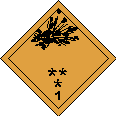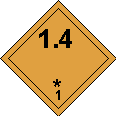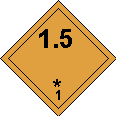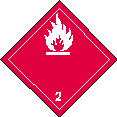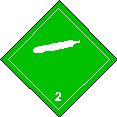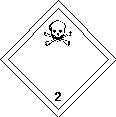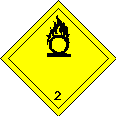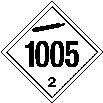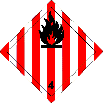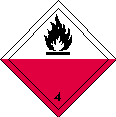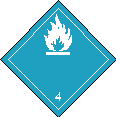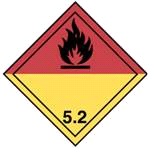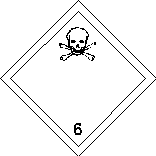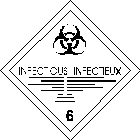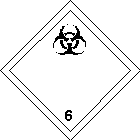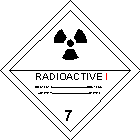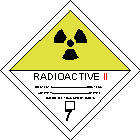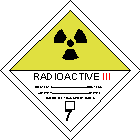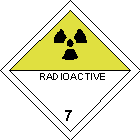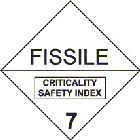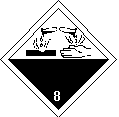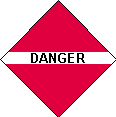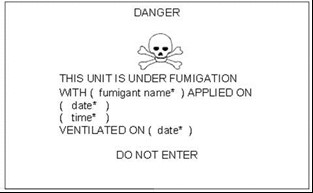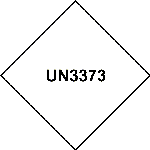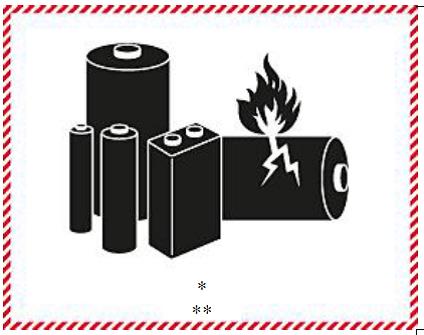TDG Regulations
The TDG Regulations have been consolidated to include amendment SOR/2019-101 (Emergency Response Assistance Plan).
Disclaimer: These documents are not the official versions
(more details).
DANGEROUS GOODS SAFETY MARKS
TABLE OF CONTENTS
Background
Definitions
Background
Dangerous goods safety marks are required to be displayed on a means of containment containing dangerous goods in transport. Dangerous goods safety marks include labels, placards, orange panels, signs, marine pollutant marks, numbers, letters, abbreviations and words used to identify dangerous goods and to show the nature of the danger they pose.
Dangerous goods safety marks give a quick identification of dangerous goods in the event of an emergency situation such as an accident or an accidental release of dangerous goods from a means of containment.
Dangerous goods safety marks are also an awareness tool for people involved in transportation, including truck drivers, train crews, loading dock workers, reception personnel at a lab or a hospital and aircraft loading personnel.
Generally, labels are displayed on small means of containment and placards are displayed on large means of containment.
SOR/2017-253
DANGEROUS GOODS SAFETY MARKS
Definitions
Definitions for the following terms, used in this Part, are provided in Part 1, Coming into Force, Repeal, Interpretation, General Provisions and Special Cases:
- accidental release SOR/2014-159
- Act
- aircraft
- CANUTEC
- capacity SOR/2014-159
- carrier
- Category B SOR/2014-159
- 49 CFR
- class
- compatibility group
- consignment
- consignor
- consolidation bin SOR/2014-159
- cylinder
- dangerous goods
- dangerous goods safety mark
- ERAP SOR/2019-101
- flash point
- gas
- gross mass
- handling SOR/2014-159
- ICAO Technical Instructions SOR/2014-159
- imminent accidental release SOR/2014-159
- import
- infectious substance
- in transport
- large means of containment
- liquid
- means of containment
- means of transport
- net explosives quantity SOR/2014-159
- offer for transport
- overpack SOR/2014-159
- packing group
- person
- prescribed
- primary class
- public safety SOR/2014-159
- railway vehicle
- road vehicle
- ro-ro ship SOR/2017-253
- safety mark
- shipping name
- small means of containment
- solid
- special provision
- subsidiary class
- substance
- technical name
- transport index
- UN number
- UN Recommendations
- vessel SOR/2017-253
4.1 Requirements for Dangerous Goods Safety Marks
A person must not offer for transport, transport or import a means of containment that contains dangerous goods unless each dangerous goods safety mark required by this Part and illustrated in the appendix to this Part, or illustrated in Chapter 5.2 or 5.3 of the UN Recommendations, is displayed on it in accordance with this Part.
SOR/2012-245
4.1.1 Voluntary Display of a Placard
SOR/2014-159
When a person transports dangerous goods in or on a road vehicle or railway vehicle and the person voluntarily displays a placard on the vehicle, the following provisions apply:
- (a) section 4.2;
- (b) sections 4.6 and 4.7;
- (c) subsection 4.9(2);
- (d) sections 4.14 to 4.15.1;
- (e) paragraphs 4.15.3(a) and (b); and
- (f) section 4.16.
SOR/2014-159
4.2 Misleading Dangerous Goods Safety Marks
- (1) As provided for in section 6.1 of the Act, a person must not display a dangerous goods safety mark on a means of containment or a means of transport if the mark is misleading as to the presence or nature of any danger.
For example, placards on a road vehicle transporting 220 kg of dangerous goods are not misleading as long as the placards accurately indicate the presence of dangerous goods and the nature of the danger they pose. - (2) As provided for in section 6.1 of the Act, a person must not display a mark other than a dangerous goods safety mark on a means of containment or a means of transport if the other mark is likely to be mistaken for a dangerous goods safety mark or is misleading as to the presence or nature of any danger.
SOR/2014-159
4.3 Display of Dangerous Goods Safety Marks Before Loading or Packing a Large Means of Containment
A person must not load or pack dangerous goods into a large means of containment for transport unless, immediately before the loading or packing, the large means of containment has displayed on it the dangerous goods safety marks that will be required when the loading or packing is complete.
4.4 Consignor Responsibilities
- (1) Before importing dangerous goods or allowing a carrier in Canada to take possession of dangerous goods for transport, the consignor must
- (a) display or ensure the display of the required dangerous goods safety marks on each small means of containment that contains the dangerous goods;
- (b) display or ensure the display of the required dangerous goods safety marks on each large means of containment that contains the dangerous goods; and
SOR/2008-34 - (c) provide to the carrier the dangerous goods safety marks for the dangerous goods that the consignor is offering for transport or importing and that are to be transported in a large means of containment.
- (2) The consignor is not required to provide the dangerous goods safety marks referred to in paragraph (1)(c) if they
- (a) are already displayed on the large means of containment; or
- (b) are not the correct ones to display because of the presence of other dangerous goods in the large means of containment.
When the consignor provides the large means of containment, the consignor displays the dangerous goods safety marks. When the carrier provides the large means of containment, the consignor provides
the carrier with the appropriate dangerous goods safety marks.
4.5 Carrier Responsibilities
The carrier of dangerous goods must
- (a) ensure that the required dangerous goods safety marks remain displayed on the small means of containment while the dangerous goods are in transport;
- (b) display the required dangerous goods safety marks on the large means of containment, unless they are already displayed on it, and ensure that they remain displayed while the dangerous goods are in transport; and
- (c) provide and display, or remove, the dangerous goods safety marks if the requirements for dangerous goods safety marks change while the dangerous goods are in transport.
SOR/2008-34
4.6 Visibility, Legibility and Colour
Dangerous goods safety marks must be
- (a) visible, legible and displayed against a background of contrasting colour;
- (b) made of durable and weather-resistant material that will withstand the conditions to which they will be exposed without substantial detachment or deterioration of their colour, symbols, letters, text or numbers; and
For example, deterioration is considered substantial if the colour of the safety mark fades or darkens so that it is no longer the colour that represents the class of dangerous goods associated with it.
- (c) displayed in the colours specified in
- (i) the appendix to this Part, which colours must conform to the following standards in the PANTONE ® "Formula Guide", published by Pantone Inc., 590 Commerce Boulevard, Carlstadt, New Jersey 07072-3098, United States:
- (A) for blue, PANTONE 285,
- (B) for green, PANTONE 335,
- (C) for orange, PANTONE 151,
- (D) for red, PANTONE 186, and
- (E) for yellow, PANTONE 109,
- (ii) Part 172 of 49 CFR, or
- (iii) Chapters 5.2 and 5.3 of the UN Recommendations.
- (i) the appendix to this Part, which colours must conform to the following standards in the PANTONE ® "Formula Guide", published by Pantone Inc., 590 Commerce Boulevard, Carlstadt, New Jersey 07072-3098, United States:
4.7 Labels and Placards: Size and Orientation
- (1) Labels and placards must be displayed on a means of containment as they are illustrated in the appendix to this Part, that is, a square on a point.
- (2) Each side of a label must be at least 100 mm in length with a line running 5 mm inside the edge. However, except for dangerous goods included in Class 7, Radioactive Materials, if that size label, together with the shipping name, technical name and UN number, cannot be displayed because of the irregular shape or size of the small means of containment, each side of the label may be reduced in length by the same amount to the point where the label, together with the shipping name, technical name and UN number, will fit that small means of containment, but must not be reduced to less than 30 mm.
If 30 mm will not fit, subsection 4.10(4) allows the label to be displayed on a tag attached to the means of containment. - (3) Each side of a placard must be at least 250 mm in length and, except for the DANGER placard, have a line running 12.5 mm inside the edge. However, except for dangerous goods included in Class 7, Radioactive Materials, if that size placard cannot be displayed because of the irregular shape or size of the large means of containment, each side of the placard may be reduced in length by the same amount to the point where the placard will fit that large means of containment, but must not be reduced to less than 100 mm.
- (4) If the size of a label or a placard is reduced, every symbol, letter and number required on that label or placard must be reduced proportionately.
- (5) If a large means of containment contains dangerous goods included in Class 7, Radioactive Materials, and a Class 7 placard is required to be displayed in accordance with this Part, the means of containment must have displayed on it the Class 7 placard required or the appropriate optional Class 7 placard illustrated in the appendix to this Part.
SOR/2008-34
4.8 Ways to Display a UN Number
- (1) A UN number that is required by this Part to be displayed on a small means of containment or on a tag attached to it must be displayed in one of the following ways:
- (a) next to the primary class label for the dangerous goods; or
- (b) within a white rectangle located on the primary class label for the dangerous goods, without the prefix "UN", but it must not obscure the symbol, class number, compatibility group letter or text on the label.
The illustration showing the UN number to the right of the placard is an example only and does not indicate a mandatory position. For example, a wrap-around label may be used on a cylinder.
- (2) A UN number that is required by this Part to be displayed on a large means of containment must be displayed in black numerals not less than 65 mm high in one of the following ways:
SOR/2008-34- (a) on an orange panel placed next to the primary class placard for the dangerous goods, without the prefix "UN"; or
- (b) within a white rectangle located on the primary class placard for the dangerous goods, without the prefix "UN", but it must not obscure the symbol, class number, compatibility group letter or text on the placard.
4.9 Removal or Change of Dangerous Goods Safety Marks
SOR/2008-34
- (1) When the conditions that required the display of dangerous goods safety marks change, the person having the charge, management or control of the means of containment must determine, as a result of the new conditions, whether the dangerous goods safety marks must be changed or removed.
- (2) The person who neutralizes the contents of the means of containment or who unloads, unpacks, cleans or purges the means of containment must cover or remove the dangerous goods safety mark when the danger indicated by the dangerous goods safety mark is no longer present in the means of containment.
- (3) When the DANGER placard is permitted to be displayed on a large means of containment, a person may continue to display that placard, in place of any other placard, until the large means of containment no longer contains any of the dangerous goods identified by that placard.
SOR/2014-159
4.10 Labels on a Small Means of Containment
SOR/2014-159
- (1) One label must be displayed on a small means of containment for the primary class and one for each subsidiary class set out in column 3 of Schedule 1 for each of the dangerous goods in transport in the small means of containment, except that
SOR/2017-137
- (a) a label is not required to be displayed on a small means of containment that is inside another small means of containment if the other small means of containment has a label displayed on it and is not opened during loading or unloading or while the dangerous goods are in transport;
- (b) the oxidizing gas label, illustrated in the appendix to this Part, must be displayed on a small means of containment for the following dangerous goods:
- (i) UN1072, OXYGEN, COMPRESSED;
- (ii) UN1073, OXYGEN, REFRIGERATED LIQUID;
- (iii) UN3156, COMPRESSED GAS, OXIDIZING, N.O.S.; and
- (iv) UN3157, LIQUEFIED GAS, OXIDIZING, N.O.S.;
SOR/2008-34
- (b.1) the Class 9, lithium battery label, illustrated in the appendix to this Part, must be displayed on a small means of containment for the following dangerous goods:
- (i) UN3090, LITHIUM METAL BATTERIES,
- (ii) UN3091, LITHIUM METAL BATTERIES CONTAINED IN EQUIPMENT or LITHIUM METAL BATTERIES PACKED WITH EQUIPMENT,
- (iii) UN3480, LITHIUM ION BATTERIES, and
- (iv) UN3481, LITHIUM ION BATTERIES CONTAINED IN EQUIPMENT or LITHIUM ION BATTERIES PACKED WITH EQUIPMENT;
- (c) if the dangerous goods are included in Class 7, Radioactive Materials, two labels must be displayed on the small means of containment for the primary class, and
SOR/2008-34 - (d) when the dangerous goods are included in Class 2, Gases, and are contained in a combination of cylinders each with a capacity greater than 225 L that are a single unit as a result of being interconnected through a piping arrangement, and are permanently mounted on a structural frame for transport, and have a combined capacity exceeding 450 L, the combination of cylinders may be placarded as one large means of containment.
SOR/2008-34
- (2) For the subsidiary class of Class 1, the label to be displayed is the label for Class 1.1, 1.2 or 1.3 illustrated in the appendix to this Part.
The dangerous goods that have a subsidiary class of Class 1 are listed in paragraph 2.8(1)(a) in Part 2, Classification, and have "(1)" shown in column 3 of Schedule 1. - (3) When a label is required to be displayed, it must be displayed
- (a) on any side of the outer surface of a small means of containment other than the side on which it is intended to rest or to be stacked during transport;
- (b) on or near the shoulder of a cylinder containing dangerous goods; or
SOR/2002-306 - (c) in the case of a label for dangerous goods included in Class 7, Radioactive Materials, on two opposite sides of the outer surface of a small means of containment, other than the side on which it is intended to rest or to be stacked during transport.
- (4) Despite subsection (3), a label with sides that are reduced to 30 mm in length in accordance with subsection 4.7(2) may be displayed on a tag that is securely attached to a small means of containment.
- (5) Despite subsection (1), a label is not required to be displayed on a small means of containment that contains a radioactive material if the shipping name and UN number of the radioactive material are displayed on the small means of containment and
- (a) the radioactive material is contained in an exposure device, as defined in the "Nuclear Substances and Radiation Devices Regulations", and the small means of containment is marked in accordance with paragraph 16(5)(a) of the "Packaging and Transport of Nuclear Substances Regulations"; or
- (b) the radioactive material is LSA-I material, as defined in subsection 1(1) of the "Packaging and Transport of Nuclear Substances Regulations", and the small means of containment is marked in accordance with paragraph 16(5)(c) of the "Packaging and Transport of Nuclear Substances Regulations".
SOR/2014-159
4.10.1 Safety Marks on an Overpack
SOR/2014-159
- (1) When a safety mark is required by this Part to be displayed on a small means of containment and the small means of containment is inside an overpack, the person who prepares the overpack must display
- (a) the word "Overpack" or "Suremballage", in letters that are at least 12 mm high on a contrasting background, on at least one side of the overpack;
SOR/2017-137 - (b) the information required by subsection (3) on one side of the overpack, if its capacity is less than 1.8 m3 (64 cubic feet); and
- (c) the information required by subsection (3) on two opposite sides of the overpack, if its capacity is greater than or equal to 1.8 m3 (64 cubic feet).
- (a) the word "Overpack" or "Suremballage", in letters that are at least 12 mm high on a contrasting background, on at least one side of the overpack;
- (2) Subsection (1) does not apply if a safety mark for each class of dangerous goods inside the overpack is visible through the overpack.
SOR/2017-137 - (3) The following information must be displayed on the overpack:
- (a) the primary class label and each subsidiary class label for each of the dangerous goods contained in the overpack, except that only one label is required for dangerous goods that are included in the same class; and
- (b) the shipping name and UN number of the dangerous goods.
- (4) When dangerous goods included in Class 7, Radioactive Materials, are transported in an overpack and a label is required to be displayed by this Part, the overpack must be prepared in accordance with section 16(4) of the "Packaging and Transport of Nuclear Substances Regulations".
SOR/2014-159
4.10.2 Safety Marks on a Consolidation Bin
SOR/2014-159
When a label is required by this Part to be displayed on a small means of containment that is inside a consolidation bin, an indication of each class of dangerous goods contained in the consolidation bin must be clearly and legibly marked on a tag or fixed display device that is attached to the bin.
SOR/2014-159
4.11 Shipping Name and Technical Name on a Small Means of Containment or on a Tag
- (1) When dangerous goods in transport are in a small means of containment on which a primary class label for the dangerous goods must be displayed, the shipping name of the dangerous goods must be displayed next to the primary class label.
SOR/2008-34 - (2) When dangerous goods in transport are subject to special provision 16 and are in a small means of containment on which the shipping name is displayed, the technical name of at least one of the most dangerous substances that predominantly contributes to the hazard or hazards posed by the dangerous goods must be displayed, in parentheses, following the shipping name.
SOR/2014-306 - (3) When the primary class label for dangerous goods in transport is displayed on a tag in accordance with subsection 4.10(4), the shipping name and, when required by subsection (2), the technical name of the dangerous goods must also be displayed on the tag.
4.12 UN Numbers on a Small Means of Containment or on a Tag
- (1) When dangerous goods in transport are in a small means of containment on which the primary class label for the dangerous goods is displayed, the UN number for the dangerous goods must be displayed on or next to the primary class label.
- (2) When the primary class label for dangerous goods in transport is displayed on a tag in accordance with subsection 4.10(4), the UN number must also be displayed on the tag on or next to the primary class label.
4.13 Repealed SOR/2017-253
4.14 Class 7, Radioactive Material
SOR/2008-34
- (1) For dangerous goods included in Class 7, Radioactive Material, the label or placard required to be displayed by this Part must be determined in accordance with the "Packaging and Transport of Nuclear Substances Regulations".
SOR/2008-34 - (2) For dangerous goods included in Class 7, Radioactive Material, the following information must be determined in accordance with the "Packaging and Transport of Nuclear Substances Regulations", and must be displayed on the primary class label for the dangerous goods:
- (a) the name or symbol of the radionuclide, except that if there is a mixture of radionuclides, the name or symbol of the most restrictive of the radionuclides in the mixture; and
- (b) the activity and the transport index of the dangerous goods.
SOR/2008-34
4.15 Placards on a Large Means of Containment
SOR/2014-159
- (1) The primary class placard for each of the dangerous goods contained in a large means of containment, other than a vessel or an aircraft, must be displayed on each side and on each end of the large means of containment.
SOR/2017-253 - (2) If two or more dangerous goods have different UN numbers but are identified by the same placard or placards, the placard or placards are required to be displayed only once on each side and on each end of a large means of containment.
Each placard needs to be displayed only once on each side and each end of a large means of containment regardless of how many products in the large means of containment have that class (primary or subsidiary).
For example, if UN1052, HYDROGEN FLUORIDE, ANHYDROUS (primary class 8 and subsidiary class 6.1), and UN1541, ACETONE CYANOHYDRIN, STABILIZED (class 6.1), are transported together in a truck, only 2 placards are required to be displayed on each side and on each end of the truck: the Class 8 placard (Corrosives) and the Class 6.1 placard (Toxic Substances).
SOR/2014-159
4.15.1 Subsidiary Class Placards on a Large Means of Containment
SOR/2014-159
A subsidiary class placard for dangerous goods must be displayed, next to the primary class placard for the dangerous goods, on each side and on each end of a large means of containment if the dangerous goods require an ERAP and
SOR/2019-101
- (a) have a subsidiary class of Class 1, Explosives, in which case the placard is the one illustrated for Class 1.1, 1.2 or 1.3 in the appendix to this Part;
- (b) have a subsidiary class of Class 4.3, Water-reactive Substances, in which case the placard is the one illustrated for Class 4.3 in the appendix to this Part;
- (c) have a subsidiary class of Class 6.1, Toxic Substances, and are included in Packing Group I due to inhalation toxicity, in which case the placard is the one illustrated for Class 6.1 in the appendix to this Part; or
- (d) have a subsidiary class of Class 8, Corrosives, and are UN2977, RADIOACTIVE MATERIAL, URANIUM HEXAFLUORIDE, FISSILE, or UN2978, RADIOACTIVE MATERIAL, URANIUM HEXAFLUORIDE, non-fissile or fissile excepted, in which case the placard is the one illustrated for Class 8 in the appendix to this Part.
SOR/2014-159
4.15.2 UN Numbers on a Large Means of Containment
SOR/2014-159
UN numbers, except UN numbers for dangerous goods included in Class 1, Explosives, must be displayed on a large means of containment in accordance with subsection 4.8(2) if the dangerous goods
- (a) are in a quantity or concentration for which an ERAP is required; or
SOR/2019-101 - (b) are a liquid or a gas in direct contact with the large means of containment.
SOR/2014-159
4.15.3 Placards and UN Numbers on a Large Means of Containment
SOR/2014-159
A placard, or a placard and UN number, must be displayed on each side and on each end of a large means of containment, except that
- (a) in the case of a large means of containment that is permanently connected to a frame, such as a truck frame or a supporting frame for the means of containment, the placard, or the placard and UN number, may be displayed on the frame if the resulting position of the placard, or the placard and UN number, is equivalent on each side and on each end of the means of containment;
- (b) in the case of a large means of containment that is a trailer unit, the placard, or the placard and UN number, may be displayed on the front of the vehicle that is attached to the trailer unit rather than on the leading end of the trailer unit; and
The trailer unit of a truck includes a tank. - (c) in the case of a large means of containment that is an intermediate bulk container (IBC) with a capacity greater than 450 L but less than or equal to 3 000 L,
- (i) a placard and UN number may be displayed on two opposite sides of the IBC, or
- (ii) a label for each primary and subsidiary class as well as a UN number and a shipping name may be displayed on two opposite sides of the IBC.
When IBCs that have labels on them are inside a road vehicle or railway vehicle or are loaded onto a road vehicle or railway vehicle, the requirements of this Part for the display of placards on the road vehicle or railway vehicle still apply.
SOR/2014-159
4.15.4 Visibility of Labels, Placards and UN Numbers on a Large Means of Containment
SOR/2014-159
- (1) When a large means of containment that has labels or placards displayed on it is inside another large means of containment and those labels or placards are not visible, the placards required by this Part must be displayed on the outer large means of containment. The UN numbers that are required by this Part must also be displayed on the outer large means of containment.
- (2) When a large means of containment that has labels, placards, labels and UN numbers, or placards and UN numbers, displayed on it is loaded onto another large means of containment and those labels, placards, labels and UN numbers, or placards and UN numbers, are visible, the placards, or placards and UN numbers, are not required to be displayed on the other large means of containment.
For example, IBCs carried on a flatbed truck
SOR/2014-159
4.16 DANGER Placard
SOR/2014-159
The display of a DANGER placard is not mandatory, but if it is not displayed, compliance with section 4.15 is required and the primary class placards for the dangerous goods must be displayed. However, compliance with section 4.15 is always required for dangerous goods that are not allowed to be identified by the DANGER placard but that may be loaded into the same large means of containment.
- (1) Except in the case of the dangerous goods listed in subsection (2) or a flammable gas referred to in subsection (3), a DANGER placard is permitted to be displayed on a large means of containment instead of any other placard required by section 4.15, if
- (a) the large means of containment contains two or more dangerous goods that require different placards; and
- (b) the dangerous goods loaded into the large means of containment are contained in two or more small means of containment
- (2) The DANGER placard referred to in subsection (1) must not be displayed on a large means of containment for
- (a) dangerous goods that have a gross mass greater than 1 000 kg, are included in the same class and are offered for transport by one consignor;
- (b) dangerous goods that require an ERAP;
SOR/2019-101 - (c) dangerous goods included in Class 1, Explosives;
- (d) dangerous goods included in Class 2.3, Toxic Gases;
- (e) dangerous goods included in Class 4.3, Water-reactive Substances;
- (f) dangerous goods included in Class 5.2, Organic Peroxides, Type B, liquid or solid, that require a control or emergency temperature;
- (g) dangerous goods included in Class 6.1, Toxic Substances, that are subject to special provision 23; and
- (h) dangerous goods included in Class 7, Radioactive Materials, that require a Category III – Yellow label.
- (3) If a road vehicle or railway vehicle to be transported by vessel contains a flammable gas, the flammable gas placard illustrated in the appendix to this Part must be displayed on the road vehicle or railway vehicle.
SOR/2017-253
4.16.1 Placarding Exemption for Dangerous Goods Having a Gross Mass of 500 kg or Less
SOR/2014-159
Subsection (1) provides an exemption from placarding requirements if the dangerous goods in or on a road vehicle or railway vehicle have a gross mass that is less than or equal to 500 kg.
Subsection (2) sets out which dangerous goods cannot be counted in the 500 kg and are, therefore, subject to the placarding requirements.
For example, a road vehicle contains 2 300 kg of dangerous goods. Of that quantity, 2 000 kg are dangerous goods that meet one of the conditions in subsection (2) and 300 kg are dangerous goods that do not meet any of the conditions in subsection (2).
The 2 000 kg of dangerous goods that meet one of the conditions in subsection (2) require a placard, but the remaining 300 kg of dangerous goods do not require a placard.
- (1) Except in the case of the dangerous goods listed in subsection (2), a placard is not required to be displayed on a road vehicle or railway vehicle if the dangerous goods in or on the road vehicle or railway vehicle have a gross mass that is less than or equal to 500 kg.
- (2) The exemption set out in subsection (1) does not apply to dangerous goods
- (a) requiring an ERAP;
SOR/2019-101 - (b) requiring the display of a subsidiary class placard in accordance with section 4.15.1;
- (c) included in Class 1, Explosives, except for
- (i) explosives referred to in subsection 4.17(1), and
- (ii) explosives included in Class 1.1, 1.2, 1.3 or 1.5, if
- (A) the explosives are not subject to special provision 85 or 86 and have a net explosives quantity that is less than or equal to 10 kg, or
- (B) the explosives are subject to special provision 85 or 86 and the number of articles of explosives is less than or equal to 1 000;
- (d) included in Class 2.1, Flammable Gases, if the road vehicle or railway vehicle is to be transported by vessel;
SOR/2017-253 - (e) included in Class 2.3, Toxic Gases;
- (f) included in Class 4.3, Water-reactive Substances;
- (g) included in Class 5.2, Organic Peroxides, Type B, liquid or solid, that require a control or emergency temperature;
- (h) included in Class 6.1, Toxic Substances, that are subject to special provision 23; or
- (i) included in Class 7, Radioactive Materials, that require a Category III – Yellow label.
SOR/2014-159
- (a) requiring an ERAP;
4.17 Class 1, Explosives
SOR/2014-159
- (1) Despite section 4.15, a placard is not required to be displayed for explosives that are included in
- (a) Class 1.4, except for UN0301, AMMUNITION, TEAR-PRODUCING, and are in a quantity that is less than or equal to 1 000 kg net explosives quantity; or
SOR/2008-34 - (b) Class 1.4S and are in any quantity.
SOR/2019-101
- (a) Class 1.4, except for UN0301, AMMUNITION, TEAR-PRODUCING, and are in a quantity that is less than or equal to 1 000 kg net explosives quantity; or
- (2) Despite section 4.15, only the placard for the explosives with the lowest division number is required to be displayed for explosives that are included in more than one division and are in a large means of containment, except in the following cases:
- (a) when explosives included in Class 1.2 and Class 1.5 are transported together, the placard for Class 1.1 must be displayed; and
- (b) when explosives included in Class 1.4 and Class 1.5 are transported together, the placard for Class 1.5 must be displayed.
- (3) Repealed SOR/2014-159
4.18 Options for Class 2, Gases
SOR/2014-159
Despite section 4.15, if a road vehicle transporting toxic gases, flammable gases or oxygen, or gases included in Class 2.2, Non-Flammable and Non-toxic Gases, is placarded with the Toxic Gases placard, the following placards are not required to be displayed on the road vehicle:
- (a) the Flammable Gases placard;
- (b) the Oxidizing Gases placard; and
- (c) the Non-Flammable and Non-toxic Gases placard.
SOR/2014-159
4.18.1 Class 2, Gases: Placards for Oxidizing Gases
SOR/2014-159
When dangerous goods included in Class 2, Gases, and contained in a large means of containment are oxidizing gases, the oxidizing gas placard illustrated in the appendix to this Part must be displayed on the large means of containment for the following dangerous goods instead of the placard required by section 4.15, but if an ERAP is required for the dangerous goods the UN number must also be displayed:
SOR/2019-101
- (a) UN1072, OXYGEN, COMPRESSED;
- (b) UN1073, OXYGEN, REFRIGERATED LIQUID;
- (c) UN3156, COMPRESSED GAS, OXIDIZING, N.O.S.; and
- (d) UN3157, LIQUEFIED GAS, OXIDIZING, N.O.S.
SOR/2014-159
4.18.2 Class 2, Gases: Placards for UN1005, ANHYDROUS AMMONIA
SOR/2014-159
When UN1005, ANHYDROUS AMMONIA, is contained in a large means of containment, the large means of containment must have displayed on it
- (a) the Class 2.3 placard and a UN number; or
- (b) the anhydrous ammonia placard and, on at least two sides, the words "Anhydrous Ammonia, Inhalation Hazard" or "Ammoniac anhydre, dangereux par inhalation" in letters
- (i) at least 6 mm wide and 100 mm high in the case of a tank car,
- (ii) at least 4 mm wide and 25 mm high in the case of a portable tank, and
SOR/2017-253 - (iii) at least 6 mm wide and 50 mm high in the case of all other large means of containment.
SOR/2017-137
4.18.3 Class 2, Gases: Placards for Tube Trailers
SOR/2014-159
When dangerous goods included in Class 2, Gases, are contained in a combination of tubes that are a single unit as a result of being interconnected through a piping arrangement and are permanently mounted on a structural frame for transport, the combination of tubes may be placarded as if it were one large means of containment.
SOR/2014-159
4.19 Placards and UN Numbers on a Compartmentalized Large Means of Containment
SOR/2014-159
- (1) When dangerous goods included in different primary classes are transported in different compartments of a compartmentalized large means of containment,
- (a) the primary class placard and the UN number for the dangerous goods in each compartment must be displayed on each side of that compartment; and
- (b) each placard and UN number displayed in accordance with paragraph (a) must be displayed on each end of the compartmentalized large means of containment but each specific placard need only be displayed once on each end.
SOR/2008-34
- (2) When all compartments in a compartmentalized large means of containment contain dangerous goods included in the same primary class,
- (a) the primary class placard must be displayed on each side and on each end of the compartmentalized large means of containment; and
- (b) the UN number of the dangerous goods in a compartment must be displayed on each side of that compartment and on each end of the compartmentalized large means of containment, except that, if all the dangerous goods are included in Class 3, Flammable Liquids, only the UN number of the dangerous goods with the lowest flash point is required to be displayed on each side and on each end of the compartmentalized large means of containment.
SOR/2014-159
- (3) Despite paragraph (2)(b), if a compartmentalized large means of containment contains UN3475, ETHANOL AND GASOLINE MIXTURE, the number "3475" must be displayed, in addition to the UN number — without the prefix "UN" — of the dangerous goods with the lowest flash point, on each side and on each end of the compartmentalized large means of containment.
SOR/2017-137
4.20 Elevated Temperature Sign
- (1) In addition to the requirements for placards and UN numbers in section 4.15, the elevated temperature sign must be displayed for dangerous goods that are contained in a large means of containment and that are offered for transport or transported at a temperature greater than or equal to
- (a) 100°C if the dangerous goods are in a liquid state; and
- (b) 240°C if the dangerous goods are in a solid state.
- (2) The elevated temperature sign must be displayed on each side and on each end of the large means of containment next to each primary class placard for the dangerous goods or, if there is a subsidiary class placard, next to the subsidiary class placard.
SOR/2014-306
4.21 Fumigation Sign
- (1) If the fumigation of a large means of containment is done using dangerous goods, the fumigation sign must be displayed at or next to each entryway through which a person can enter into the large means of containment. The consignor must ensure that the fumigation sign is displayed by the person in charge of the fumigation process and that the sign has displayed on it the name of the fumigant, the date and time the fumigant was applied and the date of ventilation.
- (2) The fumigation sign must continue to be displayed on a large means of containment that has been fumigated until
- (a) the large means of containment has been ventilated to remove harmful concentrations of the fumigant; and
- (b) the dangerous goods that were in the large means of containment during the fumigation have been unloaded
SOR/2014-159
4.22 Marine Pollutant Mark
- (1) In addition to the requirements for placards and UN numbers in section 4.15, the marine pollutant mark must be displayed in the following locations, for dangerous goods that are marine pollutants in transport by vessel:
SOR/2017-253- (a) on a small means of containment, next to the primary class label for the dangerous goods or, if there is a subsidiary class label, next to the subsidiary class label; and
- (b) on each side and each end of a large means of containment next to the placard that is required to be displayed for the dangerous goods.
- (2) The marine pollutant mark is not required to be displayed when marine pollutants are
- (a) on board a road vehicle or railway vehicle on a ro-ro ship;
SOR/2017-253 - (b) contained in
- (i) a small means of containment and are in a quantity that is less than or equal to 5 L for a liquid marine pollutant or 5 kg for a solid marine pollutant, or
SOR/2014-306 - (ii) a large means of containment and
- (A) are in a quantity that is less than or equal to 500 kg,
- (B) are transported by vessel on a domestic voyage, and
SOR/2017-253 - (C) the large means of containment does not contain Class 1, Explosives, other than explosives included in Class 1.4, Class 5.2, Organic Peroxides, Class 6.1, Toxic Substances, or Class 7, Radioactive Materials.
- (i) a small means of containment and are in a quantity that is less than or equal to 5 L for a liquid marine pollutant or 5 kg for a solid marine pollutant, or
- (a) on board a road vehicle or railway vehicle on a ro-ro ship;
- (3) The placard and UN number are not required to be displayed for substances identified as marine pollutants in subparagraph 2.43(b)(ii) when the marine pollutant mark is not required to be displayed in accordance with subsection (2).
SOR/2008-34
4.22.1 Category B Mark
SOR/2008-34
The Category B mark illustrated in the appendix to this Part must be displayed, instead of the Class 6.2, Infectious Substances label, on a small means of containment containing infectious substances included in UN3373, BIOLOGICAL SUBSTANCE, CATEGORY B.
SOR/2014-159
4.23 Toxic – Inhalation Hazard
SOR/2014-159
A person must not import, offer for transport, handle or transport dangerous goods that are included in Class 6.1, Toxic Substances, in accordance with paragraph 2.28(c) of Part 2 (Classification), or Class 2.3, Toxic Gases, in accordance with paragraph 2.14(c) of Part 2 (Classification), unless the words "inhalation hazard" or "dangereux par inhalation" are displayed
- (a) in the case of a small means of containment, in letters at least 12 mm high, next to the shipping name, unless these words are already part of the shipping name; and
- (b) in the case of a large means of containment, on two opposite sides of the large means of containment, in addition to any placard or placard and UN number required by this Part, in letters
- (i) at least 6 mm wide and 100 mm high in the case of a tank car,
- (ii) at least 4 mm wide and 25 mm high in the case of a portable tank or an intermediate bulk container (IBC), and
- (iii) at least 6 mm wide and 50 mm high in the case of all other large means of containment.
SOR/2017-137
4.24 Lithium Battery Mark
SOR/2017-137
- (1) For the purposes of special provision 34, the lithium battery mark, illustrated in the appendix to this Part, must indicate
- (a) "UN3090" for lithium metal cells or batteries;
- (b) "UN3480" for lithium ion cells or batteries; and
- (c) "UN3091" or "UN3481", as appropriate, for lithium cells or batteries that are contained in, or packed with, equipment.
- (2) When a means of containment contains lithium cells or batteries assigned to different UN numbers, all applicable UN numbers must be indicated on one or more marks.
- (3) Subject to subsection (4), the mark must be at least 120 mm wide × 110 mm high and the hatching must be at least 5 mm wide.
- (4) The dimensions of the mark may be reduced for a means of containment that is an irregular shape or size if
- (a) the mark is at least 105 mm wide × 74 mm high; and
- (b) every symbol, letter and number required on the mark is reduced proportionately.
SOR/2017-137
APPENDIX
ILLUSTRATION OF DANGEROUS GOODS SAFETY MARKS
Each class of dangerous goods has assigned to it a label, a placard or both. The labels and placards are illustrated below. Also illustrated is the DANGER placard, the oxidizing gas label and placard, the elevated temperature sign, the fumigation sign, the marine pollutant mark and the orange panel. The size requirements for the signs, the marine pollutant mark and the orange panel are also provided.
LABELS AND PLACARDS
CLASS 1, EXPLOSIVES
Class 1.1, 1.2, 1.3
Label and Placard
Black: Symbol, numbers, letter and line 5 mm inside the edge for a label and 12.5 mm inside the edge for a placard
Orange: Background
The symbol is an exploding bomb.
** place for division – to be left blank if explosive is a subsidiary class
* place for the Compatibility Group Letter – to be left blank if explosive is a subsidiary class
Class 1.4
Class 1.5
Class 1.6
Label and Placard
Black: Numbers, letter and line 5 mm inside the edge for a label and 12.5 mm inside the edge for a placard
Orange: Background
* place for the Compatibility Group Letter
CLASS 2, GASES
Class 2.1, Flammable Gases
Label and Placard
Black or White: Symbol, number and line 5 mm inside the edge for a label and 12.5 mm inside the edge for a placard
Red: Background
The symbol is a flame.
Class 2.2, Non-flammable and Non-toxic Gases
Label and Placard
Black or White: Symbol, number and line 5 mm inside the edge for a label and 12.5 mm inside the edge for a placard
Green: Background
The symbol is a gas cylinder.
Class 2.3, Toxic Gases
Oxidizing Gases
Label and Placard
Black: Symbol, number and line 5 mm inside the edge for a label and 12.5 mm inside the edge for a placard
White: Background
The symbol is a skull and crossbones.
Label and Placard
Black: Symbol, number and line 5 mm inside the edge for a label and 12.5 mm inside the edge for a placard
Yellow: Background
The symbol is a flame over a circle (Flaming "O").
Placard for UN1005, ANHYDROUS AMMONIA
SOR/2014-159
Black: Number, symbol and line 12.5 mm inside the edge
White: Background
The symbol is a gas cylinder.
CLASS 3, FLAMMABLE LIQUIDS
Class 3, Flammable Liquids
Label and Placard
Black or White: Symbol, number and line 5 mm inside the edge for a label and 12.5 mm inside the edge for a placard
Red: Background
The symbol is a flame.
CLASS 4, FLAMMABLE SOLIDS, SUBSTANCES LIABLE TO SPONTANEOUS COMBUSTION AND SUBSTANCES THAT ON CONTACT WITH WATER EMIT
FLAMMABLE GASES (WATER REACTIVE SUBSTANCES)
Class 4.1, Flammable Solids
Label and Placard
Black: Symbol, number and line 5 mm inside the edge for a label and 12.5 mm inside the edge for a placard
Red: 7 red stripes resulting in 13 equally spaced vertical stripes
White: Background
The symbol is a flame.
Class 4.2, Substances Liable to Spontaneous Combustion
Label and Placard
Black: Symbol, number and line 5 mm inside the edge for a label and 12.5 mm inside the edge for a placard
Red: Lower half
White: Upper half
The symbol is a flame.
Class 4.3, Water Reactive Substances
Label and Placard
Black or White: Symbol, number and line 5 mm inside the edge for a label and 12.5 mm inside the edge for a placard
Blue: Background
The symbol is a flame.
CLASS 5, OXIDIZING SUBSTANCES AND ORGANIC PEROXIDES
Class 5.1, Oxidizing Substances
Label and Placard
Black: Symbol, number and line 5 mm inside the edge for a label and 12.5 mm inside the edge for a placard
Yellow: Background
The symbol is a flame over a circle (Flaming "O").
Class 5.2, Organic Peroxides
Label and Placard
Black: Number and line 5 mm inside the edge for a label and 12.5 mm inside the edge for a placard
Black or White: Symbol
Yellow: Lower half of the background
Red: Upper half of the background
The symbol is a flame.
SOR/2014-159
CLASS 6, TOXIC AND INFECTIOUS SUBSTANCES
Class 6.1, Toxic Substances
Label and Placard
Black: Symbol, number and line 5 mm inside the edge for a label and 12.5 mm inside the edge for a placard
White: Background
The symbol is a skull and crossbones.
Class 6.2, Infectious Substances
Label
Black: Symbol, number, text and line 5 mm inside the edge
White: Background
The symbol is three crescents superimposed on a circle.
The text is:
IN CASE OF DAMAGE
OR LEAKAGE
IMMEDIATELY
NOTIFY
LOCAL AUTHORITIES
AND
EN CAS DE DOMMAGE
OU DE FUITE
COMMUNIQUER
IMMÉDIATEMENT
AVEC LES AUTORITÉS
LOCALES ET
CANUTEC
613-996-6666
Class 6.2, Infectious Substances
Placard
Black: Symbol, number and line 12.5 mm inside the edge
White: Background
The symbol is three crescents superimposed on a circle.
CLASS 7, RADIOACTIVE MATERIALS
Class 7, Radioactive Materials
Category I – White
Label and Optional Placard
Black: Symbol, number, text and line 5 mm inside the edge for a label and 12.5 mm inside the edge for a placard
Red: One vertical bar following the word "RADIOACTIVE"
White: Background
The symbol is a trefoil.
The additional text under the word "RADIOACTIVE" is:
CONTENTS CONTENU
ACTIVITY ACTIVITÉ
Class 7, Radioactive Materials
Category II – Yellow
Label and Optional Placard
Black: Symbol, number, text and line 5 mm inside the edge for a label and 12.5 mm inside the edge for a placard
Red: Two vertical bars following the word "RADIOACTIVE"
Yellow: Upper half of background excluding the border
White: Lower half of background and the border
The symbol is a trefoil.
The additional text under the word "RADIOACTIVE" is:
CONTENTS CONTENU
ACTIVITY ACTIVITÉ
INDICE DE TRANSPORT INDEX
Class 7, Radioactive Materials
Category III – Yellow
Label and Optional Placard
Black: Symbol, number, text and line 5 mm inside the edge for a label and 12.5 mm inside the edge for a placard
Red: Three vertical bars following the word "RADIOACTIVE"
Yellow: Upper half of background excluding the border
White: Lower half of background and the border
The symbol is a trefoil.
The additional text under the word "RADIOACTIVE" is:
CONTENTS CONTENU
ACTIVITY ACTIVITÉ
INDICE DE TRANSPORT INDEX
Class 7, Radioactive Materials
Category
Placard
Black: Symbol, number, text and line 12.5 mm inside the edge
Yellow: Upper half of background excluding the border
White: Lower half of background and the border
The symbol is a trefoil.
The word "RADIOACTIVE" is optional.
Class 7, Radioactive Materials
Label
Black: Number, text, outline of the box in lower half and line through the centre of the label
White: Background
CLASS 8, CORROSIVES
Class 8, Corrosives
Label and Placard
White: The number 8, upper half of background and the border
Black: Lower half of the background, except for the border and the number, and line 5 mm inside the edge for a label and 12.5 mm inside the edge for a placard
The symbol is liquid spilling from two glass vessels and attacking a hand and a metal bar.
CLASS 9, MISCELLANEOUS PRODUCTS, SUBSTANCES OR ORGANISMS AND LITHIUM BATTERIES
Class 9, Miscellaneous Products, Substances
or Organisms
SOR/2017-137
Label and Placard
Black: Symbol, number and line 5 mm inside the edge for a label and 12.5 mm inside the edge for a placard
White: Background
Symbol: 7 black stripes resulting in 13 equally spaced vertical stripes in the upper half
The number "9" underlined in bottom corner
SOR/2017-137
Class 9, Lithium Batteries
SOR/2017-137
SOR/2017-137
Label
SOR/2017-137
Black: Symbol, number and line 5 mm inside the edge
White: Background
Symbol: 7 black stripes resulting in 13 equally spaced vertical stripes in the upper half; battery group, one broken and emitting flame in lower half
The number "9" underlined in bottom corner
OTHER PLACARDS
DANGER PLACARD
Placard
Black: Text
White: Centre horizontal band forming the background for the word "DANGER"
Red: Background except for the centre band
The symbol is the word DANGER, with each letter at least 50 mm high and at least 10 mm wide.
SIGNS
ELEVATED TEMPERATURE SIGN
Red: Symbol and border
White: Background
Size: Equilateral triangle with sides of at least 250 mm in length
The symbol is a thermometer.
This sign may be displayed on a standard-sized white placard.
FUMIGATION SIGN
SOR/2017-137
Black: Symbol and text
White: Background
Size: Rectangle, at least 400 mm wide and 300 mm high with an outer line that is at least 2 mm wide
Symbol: The word "DANGER" centered on top of skull and crossbones
The lettering must be at least 25 mm high
The additional text under the symbol is:
THIS UNIT IS UNDER FUMIGATION
WITH * APPLIED ON
**
***
VENTILATED ON ****
DO NOT ENTER
* Replace with name of fumigant
** Replace with date
*** Replace with time of fumigation
**** Replace with date of ventilation
SOR/2017-137
MARKS
MARINE POLLUTANT MARK
SOR/2014-159
Black: Symbol
White: Background
Size: For small means of containment, a square on point with each side at least 100 mm in length. For large means of containment, a square on point with each side at least 250 mm in length.
The symbol is a fish and a tree.
SOR/2014-159
CATEGORY B MARK
SOR/2008-34
Letters, numbers and line: Letters and numbers at least 6 mm high and line at least 2 mm wide
White: Background, except that the background may be the colour of the means of containment if it contrasts with the letters, numbers and line
Size: Square on point with each side at least 50 mm in length
SOR/2014-159
LITHIUM BATTERY MARK
SOR/2017-137
* Replace with UN number(s)
** Replace with telephone number for additional information
Black: Symbol
White: Background
Red: Border hatching, at least 5 mm wide
Size: Rectangle, at least 120 mm wide x 110 mm high
Symbol: A group of batteries, one damaged and emitting flame, above the UN number for lithium ion or lithium metal batteries or cells
SOR/2017-137
PANELS
ORANGE PANEL
Black: Numbers and border
Orange: Background
Size: Rectangle, at least 120 mm high and 300 mm wide with a border 10 mm wide.
Replace * with the four digits of the UN number which must be at least 65 mm high.



